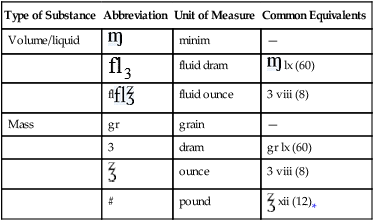Upon completion of this chapter, the learner will be able to: 1. Define the key terms that relate to the chapter. 2. Identify base measurement units used in the apothecary system. 3. Calculate equivalent measurements between the apothecary and metric systems. 4. Identify base measurement units used in household measurements (U.S. Customary System, avoirdupois system). 5. Compute equivalent measurements between household and apothecary measurements. One of the oldest measurement systems used to calculate medications based on grains and minims. The English system for measuring weight, in which 1 pound is 16 ounces; also used in the United States. Basic measurement used to determine the strength of medications. U.S. Customary System (Household Measurements) System of measurement based on common kitchen measuring utensils. In this chapter, we continue to use ratio and proportion strategies (see Chapter 5) to set up our conversion problems. In addition, we refer to the metric conversions from Chapter 7. Conversion between the metric system and the U.S. Customary System (household measurements), or the avoirdupois system, is needed by caregivers who are dispensing liquid medication in a home setting. Figure 8-1 demonstrates measuring tools commonly used in health care and home settings for dispensing liquid medication. The apothecary system is an old English system of measurement that became popular in the United States in the 18th century. The base units in the apothecary system are the grain (weight), minim (volume), and inch (length) (Box 8-1). A grain is the dry weight measurement equal to a large grain of wheat. Minims are based on the amount of liquid that equals the weight of a grain, and the inch is the approximate length of two wheat grains. The apothecary system is a familiar measurement system in the United States because household equivalents were developed for conversion from apothecary measures (Table 8-1). Because of the lack of consistent accuracy, however, the apothecary system is being phased out in favor of the metric system in the field of pharmacology. TABLE 8-1 Equivalents in the Apothecary System *Note that in the apothecary system a pound is only 12 ounces. From Fulcher RM, Fulcher E: Math calculations for pharmacy technicians: A worktext, St. Louis, 2007, Saunders. In the apothecary system, 12 ounces is equal to 1 pound, whereas the U.S. Customary System (household measurements), or the avoirdupois system, recognizes 16 ounces as equal to 1 pound. Table 8-2 provides further apothecary-to-metric conversions. TABLE 8-2 Apothecary-to-Metric Conversion Once again, let’s work with conversion problems. The box Strategy 8-1 is a reminder of how to set up the problems.
U.S. Customary Units and the Apothecary System
Objective 1
Objective 2
Apothecary system
Type of Substance
Abbreviation
Unit of Measure
Common Equivalents
Volume/liquid

minim
—

fluid dram
 lx (60)
lx (60)
fl 
fluid ounce
3 viii (8)
Mass
gr
grain
—
3
dram
gr lx (60)

ounce
3 viii (8)
#
pound
 xii (12)*
xii (12)*

Apothecary
Metric
Metric
½ grain
30 mg
1 grain
60 mg
15 grains
1,000 mg
1 G
2.2 pounds
1,000 G
1 kg
U.S. Customary Units and the Apothecary System
Get Clinical Tree app for offline access


 MATH TRIVIA 8-1
MATH TRIVIA 8-1 HUMAN ERROR 8-1
HUMAN ERROR 8-1 MATH ETIQUETTE 8-1
MATH ETIQUETTE 8-1 MATH TRIVIA 8-2
MATH TRIVIA 8-2
 STRATEGY 8-1
STRATEGY 8-1 PRACTICE THE SKILL 8-1
PRACTICE THE SKILL 8-1

